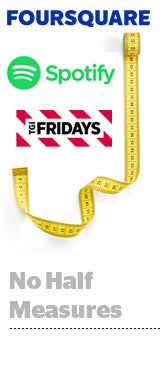Spotify and TGI Fridays are hooking up with Foursquare as a preferred measurement partner.
Solid measurement is what seals the deal with marketers, said Brian Berner, head of US sales at Spotify.
“Many of our [brand] partners have a brick-and-mortar presence, so we’ve seen increased demand for measurement that showcases how our ad platform connects to consumer behavior in the real world,” he said.
The partnership with Foursquare, announced Thursday, is part of Spotify’s effort to help advertisers understand how their ad spend is driving results by making a “connection between our streaming intelligence and offline behavior,” Berner said.
To meet that industry-wide need, Foursquare has improved attribution with machine learning. Spotify and TGI Fridays were both beta testers of the new attribution methodology.
“Real-world attribution is so critical, especially for brands like TGI Fridays that are all about guests walking through our restaurants’ doors,” said Sherif Mityas, the quick-service chain’s chief experience officer.
In the past, Foursquare would look at four main parameters to try and determine whether an ad exposure triggered an offline action: age, gender, recency and the primary DMA where someone spends their time. Starting Thursday, Foursquare is increasing the number of attributes it looks at to more than 500.
“Machine learning expands what we can do exponentially,” said Jared Hand, VP of national sales at Foursquare.
New characteristics in the mix include everything from the frequency of exposure, historical visits and the distance between a user and the store to the day of the week, time of year and what apps a person uses.
The ability to analyze a more nuanced assortment of factors also helps to more reliably suss out the difference between incremental store visits and those that might have happened anyway.
Foursquare wants advertisers to use this information for planning and tweaking campaigns in real time, rather than just tallying up store visits after they happen.
“This is information they can use to optimize their strategy, their messaging, their targeting,” Hand said. “Advertisers are putting their money into an ever-growing list of channels and partners, and they need an accurate reading on what’s performing and what’s not so they can improve their ROI.”
Cross-channel measurement is top of mind for Spotify, which worked with Foursquare in the past to measure mobile exposure, Berner said.
“But that only told part of the story, especially with the cross-channel and cross-format nature of our platform,” he said, noting that the new integration allows Spotify to measure offline attribution for audio, video and display formats running across mobile, desktop and connected devices.
In addition to Foursquare, Spotify maintains a stable of third-party measurement partners to help validate the impact of its audience and its media, including Moat, Integral Ad Science, Nielsen and comScore. Berner said Spotify plans to continue expanding its suite of measurement partners in the coming months.















